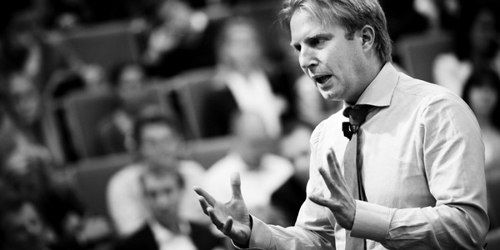Reimagining Customer Service at KLM Using Facebook and Twitter
Communication with customers through social media instead of by phone is becoming standard at global airline KLM.
Topics
Social Business
It’s probably fair to say that most air travelers had never heard of Eyjafjallajökull before it sent the global air travel industry into a tailspin. Eruptions of the Icelandic volcano in the spring of 2010 shut down air travel across western and northern Europe, completely grounding all flights for days and affecting service for weeks after.
Ground zero for the event was Iceland itself. And that put the Netherlands’ main airline, KLM, near the center of the challenge.
Martijn van der Zee, senior vice president of Air France–KLM for e-commerce, says that the volcano pushed KLM into new experiments with how it communicated with customers through social media. During the initial days and in the weeks afterwards, huge waves of customers began communicating with the company through Facebook and Twitter.
“That was the only way people could get through to us,” says van der Zee. The company, in turn, communicated back through social media.
In a conversation with Gerald C. (Jerry) Kane, an associate professor of information systems at the Carroll School of Management at Boston College and guest editor for MIT Sloan Management Review’s Social Business Big Idea Initiative, van der Zee explains how the company took what it learned during those weeks and rolled it out months later. He also explains why Brazilian fans account for over 15% of the company’s Facebook audience and how the company is gearing up to promise a 30-minute customer-response time via Twitter and Facebook by this summer.
As I understand it, your company KLM got thrown into the social media world in a big way when the Icelandic volcano interrupted global air travel in 2010.
We’ve been in a kind of rollercoaster the last three and a half years. The starting point was that ash cloud — the moment when the Icelandic volcano stopped us from flying for four days. And it wasn’t only us, but all major U.S. and European carriers across the Atlantic.
It was a very big problem for many people during those four days, but the real issues for us started when we were allowed to fly again, which was on days five, six, and seven. We had the situation where everybody wants to fly again, but 95% of seats are already taken.
That caused a kind of tsunami in communication. There’s no other word to describe it. It was a bombardment of people trying to reach us through airports, call centers, and the Web. Our website can handle a lot, but it could not handle that number of people reaching out.
That’s when people started to communicate with us in volume through Facebook and Twitter. That was the only way people could get through to us. We started to use Facebook and Twitter to give updates, which were very much appreciated. But, of course, when you give updates, people talk back.
What kinds of communications are you talking about?
We got comments like, “You’re the only ones helping and at least you’re informing us.” And then it changed into, “If you’re there giving us updates in the middle of the night, can’t you just help us? Because we’re stuck.”
And that was the start of KLM’s famous social servicing. In the end, with 160 volunteers, we started our first services through social media. It was very simple and basic with no particular tools — just communicating through social and working through our own system.
And again, you’re still talking about those days right after air traffic started back up?
Yes. Everybody in the company got involved with what social media can do, from the people normally doing office jobs to the CEO. Everybody was involved, and we got a lot of attention for it.
So, it’s a long story to describe the starting point, but it explains a little bit why, after that moment, we never had a description about whether social is important to us and if we should engage or not. That was our business case.
So did you roll out social business in a big way after that?
No. The funny thing is that, after that kind of situation, you go back to normal. What that effectively means in a large company is that everybody goes back to the silo: marketing, sales, service, risk.
Finally, at a certain moment about three months later, the CEO was so fed up that he said, “Well, Martijn, you organized it during the ash cloud. I don’t care which department does it. We just have to organize and match it in the same way.”
And that’s when we came up with a very simple social business strategy. It’s really a one-pager. We say, okay, we have to work on three things: excellent service, the brand and reputation, and commerce — because somebody has to pay for it. It would be a bit naïve to only work on service and brands with no business model behind it. In the end, somebody has to pay for all the initiatives we have to do.
I think this is where we changed course compared to other companies. Because in practice, it is pretty difficult to do.
You’ve been aggressively in social business for about four years, then. What are some of the biggest lessons you’ve learned?
One of the reasons why we are especially keen on this is that we are a very international company. Seventy percent of our social media traffic originates outside of our own country, Holland. Facebook and Twitter are pretty global, with the exceptions of a few big countries, China and Russia.
Our biggest fan bases, for instance, are in very unexpected countries like Brazil, which has only two destinations for our airline, and Malaysia, with only one destination. We’ve found that as long as your content is shareable and exciting, you see immediately a huge reach and viral effect.
For instance, Brazilian brand awareness really shot up around our Meet and Seat program that we introduced two years ago. Meet and Seat is where we allow passengers to pick their seat on a flight and link their Facebook or LinkedIn profile to the seat assignment. Passengers can pick a seat according to their interests and those of other people on the plane. On the Brazilian flights, people are so social savvy. We might have something like 30 people on a flight using it and sharing it with their friends. This application, which was just used as a nice way to differentiate ourselves from others, suddenly becomes a brand image builder, which it was never intended to be.
The initial viral effect [is something] you cannot steer. It is completely out of your hands. For us, it means that out of our 5 million Facebook fans, we have almost 1 million from Brazil. And again, this is with only two destinations in Brazil. It just happened because the Brazilians are very social savvy; they’re on Facebook all the time, and they like brands who embrace that.
That’s really fascinating. Have you considered offering more destinations in Brazil because of the number of Brazilian Facebook fans, or are you just content to be popular?
Yeah, of course. What we now do is, when we launch new services, we take, let’s say, Kuala Lumpur in Malaysia, Brazil, and San Francisco as the pilot flights, because that allows us to see whether it is interesting [to the online customer base]. You can almost make a heat map out of the world — and we do, by the way — where you see where your viral effect is going and where it does not go.
That’s great. What other examples can you share about how social is helping you operate across geographies?
The thing that seems most appreciated is still social customer service. We have a guarantee of responding within one hour on Facebook and Twitter 24/7 in 10 languages. We are working on expanding that to 14 languages. So you always get, in your own language, an answer within the hour. That’s the guarantee.
The average response time is half an hour. We are in contact with 30,000 people a week, which allows us to get the data from those people and to not only help them, but also to reach them in case of actions or other activities. We’re working on bringing the guarantee of response time from one hour to 30 minutes, which will be launched in this summer.
The challenge for us is, you really can ask anything. There’s no limit to the questions — and, of course, there are many very repetitive questions, like “Can you assign my seat?” or “Can I get an upgrade?” The challenge is to cater for all questions in all the language, so we have made a huge investment in tooling.
How do you go about guaranteeing that one-hour turnaround in social media? What do you have to do on the back end to make sure that happens?
What we do is, we have the APIs [Application Programming Interfaces] from Facebook and Twitter and VKontakte, a Russian social media. The moment a customer sends a tweet or post to us, it’s loaded into our application, and we connect the application to our own customer database, our ticketing database, our customer complaints database.
Our customer service people see everything on their screen. You would almost have to see it to believe it. It pushed the envelope for internal systems to be able to be completely real-time and to have all the information on that screen. If you don’t, you can never reach these response times.
Of course, behind the scenes we have a whole orchestration of people who make sure that the most frequently asked questions are helped the quickest so that you make sure that you don’t have any bottlenecks in the process.
And the result is, we have now 130 people around the globe working on that. And it’s so popular, the service, that it’s still not enough. We intend to increase it even further because people simply tell us, “this is, for us, a reason to buy, because it is so reassuring that we get an answer within 10 minutes without the pain of waiting on the telephone — just a rational answer.”
There are, of course, other airlines who do Twitter support, but the strength for us is doing it in people’s local language, like Spanish, Italian, Russian, Japanese. Since it’s around the clock, people know that when they’re abroad, they can always use their mobile phone to access us via mobile, Facebook and Twitter.
Do your systems provide any sort of analytics in terms of a person’s frequency of flying with you, or their social media Klout scores or whatever? Do you take a person’s social ranking, as it were, into consideration?
We do not take the Klout scores into consideration. We have them, but we made that mistake once. You don’t want a difference in wait times when a famous person has a complaint versus a person who only has two connections. The audience we have is very suspicious towards famous people getting treated differently. This is not our policy, because we know it will backfire on us.
One of our survey results showed that companies that reported that social tools helped them perform across geographies also said that social introduced new challenges, such as language, cultural, regulatory, technology issues. What challenges have you seen?
Well, we would like to share with Google Plus, but we still cannot get the API working. We are in almost continuous discussions with Google to make that happen, but so far it is not working yet. And Google seems a very obvious example.
As well, look at China, where you don’t have either Facebook or Twitter, and China is a pretty big nation for us, one of the most social savvy countries in the world. It’s totally not connected to the rest of the social infrastructure. And that really causes us problems.
How do you assess whether a particular initiative is successful or not in terms of the financial bottom line?
It is almost never a direct reference, like you would have on search advertising or in a marketing campaign. But we know that we have never been more known as a brand. Because of social, we suddenly have an edge with consumers, and we get media attention like this interview and interviews on ABC, Fox News, and CNN. Social has allowed us to stand out from the crowd.
Every time we post something, it goes to the total portfolio of countries where we have Facebook and Twitter accounts. And what is interesting is the indirect, but very clear, connection that if you look at the top 10 countries with social media followers and you see the top 10 [areas] of growth of online sales, it matches almost 90%. In some countries we get triple-digit growth in online sales just because the brand awareness is so much better than before. In the pre-social age, we simply didn’t have the means to be able to buy a TV ad or a newspaper ad in Brazil or Malaysia.
And we get emotional reactions from people. People say, “I never heard of your brand and I always fly through Frankfurt, but this time I will fly your brand because what you do is so cool.” And that’s not one isolated reaction, but something we hear hundreds of times a day.
People can really be driven to a brand by emotional engagement, can’t they?
Yes. I have a nice example of how social really helps the emotional connection. We launched a lost and found. Now, lost and found, most of the time, is handled by airports, because that is where you lose your stuff. But we had so many messages from people who lost their iPads, their telephone, sometimes their teddy bear on one of our planes. That’s emotional stuff, with pictures on it. In the past, the only thing we could do is send them to the airports because, for safety and security reasons, it’s very difficult as an airline to do something.
But you can imagine how frustrating it is if you just get out of a plane and you go through customs or you go through security, and you’re basically only 500 yards from the plane, suddenly the likelihood of getting your stuff back reduces from 90% to 5% because you can’t go back into the airport.
Based on the interactions we were having on social media, we launched a team of two people — and after a week, it was so successful that we now have 15 people. And they work the whole day just to get stuff back [to] people. The only reason we have it is because we know through listening on social when there’s a problem and we can immediately get people to go search for the stuff, go into the planes with their security clearance, and bring it back to the passenger. A five-minute look can make a really big difference.
You seem to be doing a lot of social listening to your customers as a way to come up with great programs. Are you doing anything else with social data, analyzing it for patterns and beyond that?
Yeah. We do in two ways: we do a lot of analyzing of the servicing data, so basically the 30,000 to 35,000 messages we get every week, and we know exactly what the focus is, what the sentiment is, which countries, peak hours. We really have a good view on what is being said about our company and what is working well and what is not working well.
And we are extreme in that. We know everything. We have heat maps. We have listening tools. We have analytics.
We’re working now on tech content to also stack all our activities and to follow the customer, basically, in the whole process. But what we do not do yet, and what is where we think everything comes together, is to connect the social data with our customer API. Then we will have a kind of 360-degree customer view to be able to steer whatever we do towards the customer in an analytical way.
We don’t have that ready yet, but that’s, of course, when it becomes really interesting. So, for instance, when you send us a tweet asking if you can get your favorite seat, we not only can get your seat, but we can check you in and can propose all kinds of upgrades based on your behavior.
The commercial purpose of the data mining is what many companies do, but we also foresee a great future of using that for servicing purposes. So, in other words, if we know you through social, then when we have a snowstorm coming the way of Amsterdam and we know you’re going to fly there from Boston, we can send you an advertisement or an alternative through whatever means you want to be contacted with.
Today that all runs through email, but email is a bit outdated. With this new connecting the dots of all the data, it’s very easy to push it to whatever medium. The social connection becomes interesting because I do agree with what Facebook says, that its one big edge over other social media is that it has identity. That really helps us to connect everything to all the other digital touchpoints.
That’s a long story, but basically our focus is to use data to come with practical solutions for customers. That is what we try to do.







Comment (1)
oluwagbemi Lesi